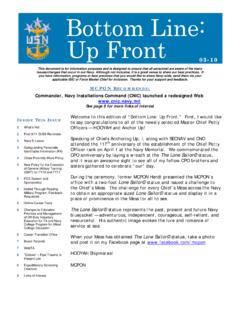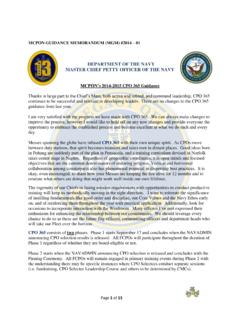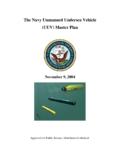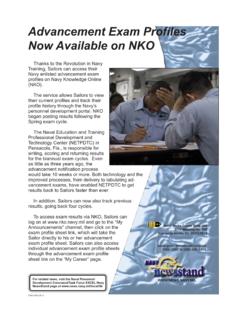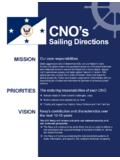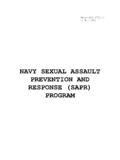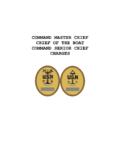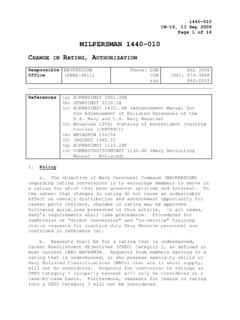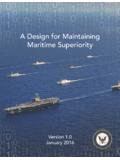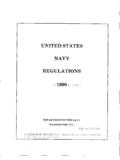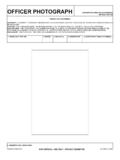Transcription of A Design for Maintaining Maritime Superiority
1 A Design for Maintaining Maritime Superiority Version January 2016. Mission The united states navy will be ready to conduct prompt and sustained combat incident to operations at sea. Our navy will protect America from attack and preserve America's strategic influence in key regions of the world. naval forces and operations from the sea floor to space, from deep water to the littorals, and in the information domain . will deter aggression and enable peaceful resolution of crises on terms acceptable to the united states and our allies and partners. If deterrence fails, the navy will conduct deci- sive combat operations to defeat any enemy. Introduction For 240 years, the navy has been a cornerstone of American security and prosperity. To continue to meet this obligation, we must adapt to the emerging security environ- ment. The initiatives laid out in this Design represent initial steps along a future course to achieve the aims articulated in the Revised Cooperative Strategy for the 21st Century (CS-21R) in this new environment.
2 It's a tremendously complex challenge. As we get underway, we must first understand our history - how we got to where we are. Moving forward, we'll respect that we won't get it all right, and so we'll monitor and assess our- selves and our surroundings as we go. We'll learn and adapt, always getting better, striv- ing to the limits of performance. This cannot be a top-down effort; everybody must contribute. PHOTO. 1. Strategic Environment On the eve of the 20th century, the united states emerged from the Civil War and laid the foundation to become a global power, but its course to continued prosperity was unclear. navy Capt. Alfred Thayer Mahan helped to chart that course, arguing that American growth required access to overseas markets, which in turn required a preeminent navy to protect that access. America became a nation with global interests, and the seas were the path to new frontiers.
3 The essence of Mahan's vision still pertains: America's interests lie beyond our own shores. What was true in the late 19th century holds true today America's success depends on our creativity, our entrepreneurism, and our access and relationships abroad. In an increasingly globalized world, America's success is even more reliant on the navy . In fulfilling our mission, it's important to start with an assessment of the security environment. It is tempting to define the challenge solely in terms of our allies, partners, and competitors the state and non-state actors on the world stage. While these are critical, it is even more important to understand the dramatic changes that have taken place on the stage itself the character of the environment in which competition and cooperation occur. Fundamentally, the world has become dramatically more globalized, and this trend is accelerating.
4 Our way ahead must account for this new reality. In particular, this Design will address three major and interrelated global forces that are increasingly used, increasingly stressed, increasingly important, and increasingly contested. These three forces energize the quickly changing environment in which the navy must operate, and if required, fight and win. The first global force is the traffic on the oceans, seas, and waterways, including the sea floor the classic Maritime system. For millennia, the seas have served to connect people and societies to help them prosper. As the global economy continues to expand and become more connected, the Maritime system is becoming increasingly used by the united states and the world as a whole. Shipping traffic over traditional sea lanes is increasing, new trade routes are opening in the Arctic, and new technologies are making undersea resources more accessible.
5 This Maritime traffic also includes mass and uncontrolled migration and illicit shipment of material and people. The Maritime system is becoming more heavily used, more stressed, and more contested than ever before. A second increasingly influential force is the rise of the global information system the information that rides on the servers, undersea cables, satellites, and wireless networks that increasingly envelop and connect the globe. Newer than the Maritime system, the information system is more pervasive, enabling an even greater multitude of connections between people and at a much lower cost of entry literally an individual with a computer is a powerful actor in this system! Information, now passed in near-real time across links that continue to multiply, is in turn driving an accelerating rate of change . from music to medicine, from microfinance to missiles.
6 2. The third interrelated force is the increasing rate of technological creation and adoption. This is not just in information technologies, where Gordon Moore's projections of exponential advances in processing, storage, and switches continue to be realized. Scientists are also unlocking new properties of commonplace materials and creating new materials altogether at astonishing speeds. Novel uses for increasingly sophisticated robotics, energy storage, 3-D printing, and networks of low-cost sensors, to name just a few examples, are changing almost every facet of how we work and live. Genetic science is just beginning to demonstrate its power. Artificial intelligence is just getting started and could fundamentally reshape the environment. And as technology is introduced at an accelerating rate, it is being adopted by society just as fast people are using these new tools as quickly as they are introduced, and in new and novel ways.
7 These three forces the forces at play in the Maritime system, the force of the information system, and the force of technology entering the environment and the interplay between them have profound implications for the united states navy . We must do everything we can to seize the potential afforded by this environment. Our competitors are moving quickly, and our adversaries are bent on leaving us swirling in their wake. And the competitors themselves have changed. For the first time in 25 years, the united states is facing a return to great power competition. Russia and China both have advanced their military capabilities to act as global powers. Their goals are backed by a growing arsenal of high-end warfighting capabilities, many of which are focused specifically on our vulnerabilities and are increasingly designed from the ground up to leverage the Maritime , technological and information systems.
8 They continue to develop and field information-enabled weapons, both kinetic and non-kinetic, with increasing range, precision and destructive capacity. Both China and Russia are also engaging in coercion and competition below the traditional thresholds of high-end conflict, but nonetheless exploit the weakness of accepted norms in space, cyber and the electromagnetic spectrum. The Russian navy is operating with a frequency and in areas not seen for almost two decades, and the Chinese PLA(N) is extending its reach around the world. Russia and China are not the only actors seeking to gain advantages in the emerging security environment in ways that threaten and global interests. Others are now pursuing advanced technology, including military technologies that were once the exclusive province of great powers this trend will only continue.
9 Coupled with a continued dedication to furthering its nuclear weapons and missile programs, North Korea's provocative actions continue to threaten security in North Asia and beyond. And while the recent international agreement with Iran is intended to curb its nuclear ambitions, Tehran's advanced missiles, proxy forces and other conventional capabilities continue to pose threats to which the navy must remain prepared to respond. Finally, international terrorist groups have proven their resilience and adaptability and now pose a long-term threat to stability and security around the world. All of these actors seek to exploit all three forces described above the speed, precision and reach that 3. the Maritime and information systems now enable, bolstered by new technologies to counter military advantages and to threaten the rules and norms that have been the basis of prosperity and world order for the last 70 years.
10 There is also a fourth force' that shapes our security environment. Barring an unforeseen change, even as we face new challenges and an increasing pace, the Defense and navy budgets likely will continue to be under pressure. We will not be able to buy our way out of the challenges that we face. The budget environment will force tough choices but must also inspire new thinking. Looking forward, it is clear that the challenges the navy faces are shifting in character, are increasingly difficult to address in isolation, and are changing more quickly. This will require us to reexamine our approaches in every aspect of our operations. But as we change in many areas, it is important to remember that there will also be constants. The nature of war has always been, and will remain, a violent human contest between thinking and adapting adversaries for political gain.
